With new industrial and warehouse development taking pace in towns and locations around the Brighton Conurbation, the City of Brighton is in danger of becoming the poor relation in terms of offering industrial and warehousing jobs, according to SHW.
SHW’s Q1 2023 Industrial Focus shows there is currently just 58,000 sq ft of industrial/warehouse space available in Brighton. This follows a take-up of 75,000 sq ft of space over the whole of 2022. With limited prospect of land being made available for industrial and warehouse development, this is leading to an escalation in rents which, in a number of cases, have doubled over the last few years from £8 to £16 per sq ft.
David Martin, SHW’s Partner and Head of Sussex Coast, says: “As always, there is a very strong demand for industrial space in the City from both existing businesses, as well as companies looking for a foothold in Brighton. The proposed new developments at Panattoni Park Brighton and Panattoni Park Burgess Hill will hopefully ease some of this pressure, particularly for companies who are under pressure to expand and do not wish to move out of the area altogether.”
David explains: “With the emphasis on new housing, industrial and warehouse stock often seems to be overlooked by Local Authorities, but at some stage this precedent does need to be seriously considered to prevent cities like Brighton just becoming a dormitory town for other locations.”
There are many developers keen to secure sites in Brighton, however the last provision of speculative industrial units over 10,000 sq ft was at Home Farm on Lewes Road in the 1980s. There have been smaller unit schemes constructed at Portland Business Park and St Joseph’s Close in Hove, as well as Woodingdean Business Park, but larger, new and modern buildings are in short supply.
David adds: “Charter Land successfully refurbished and subdivided an older building in Brighton - now called Brighton Works - within the last three years. With this scheme now being fully let, there would be scope for a Brighton Works Mark 2. The problem we are seeing is that if ever a suitable building or piece of land ever becomes available, this is normally turned over to either residential development or student housing.
“My suggestion is that where industrial estates or building are knocked down and replaced with new housing, there should be a policy in place whereby new industrial and warehouse sites are allocated to replace the lost estates. These could be on the edge of the City to keep traffic generation to a minimum, but it is a must if we are to ensure the supply of essential industrial space in the City to keep up with the high demand.”

